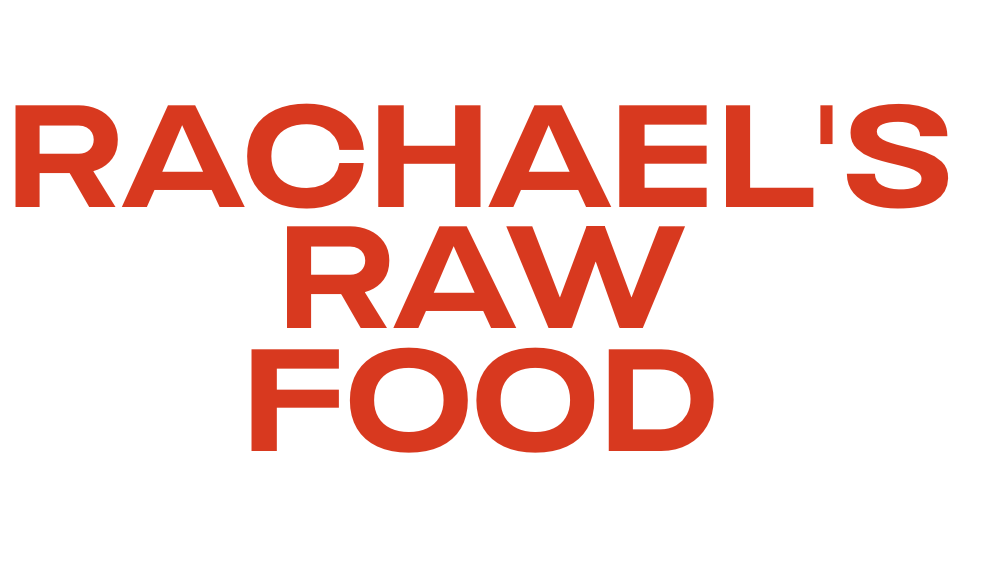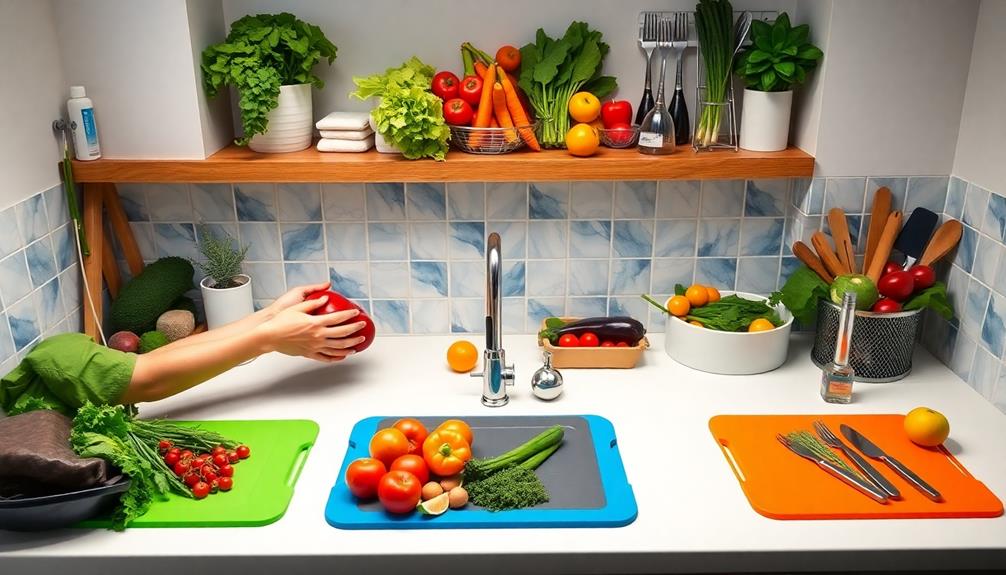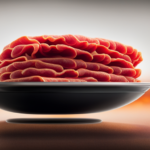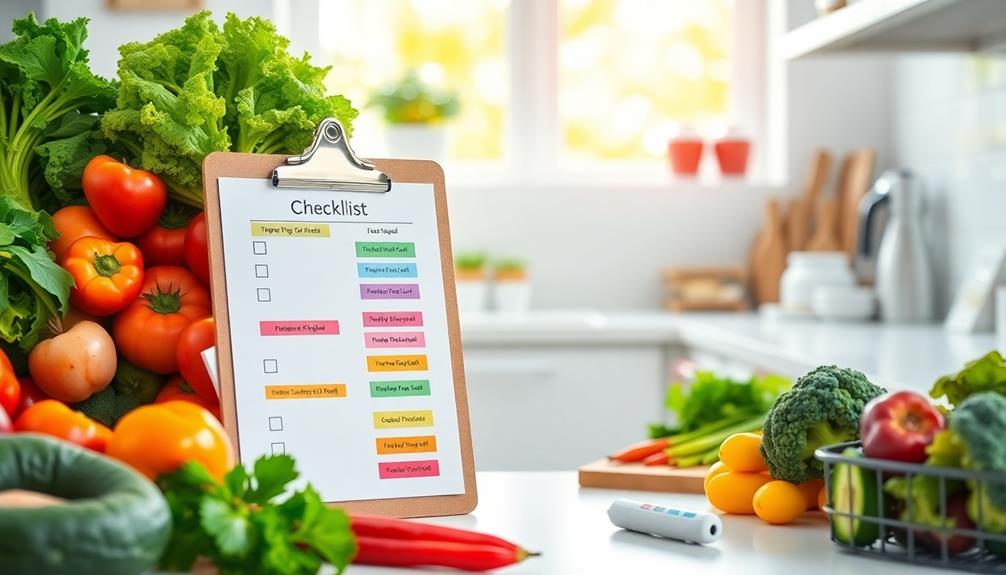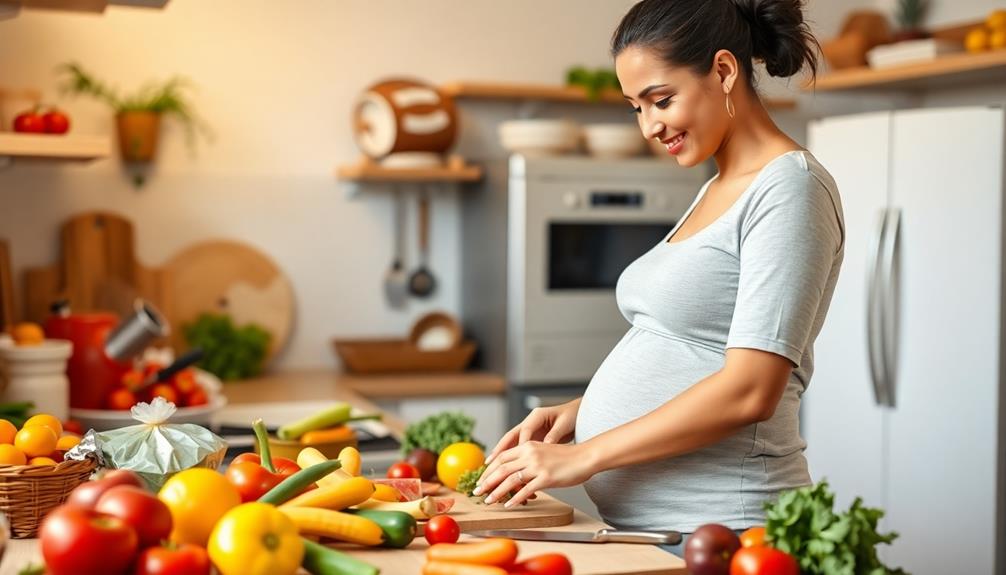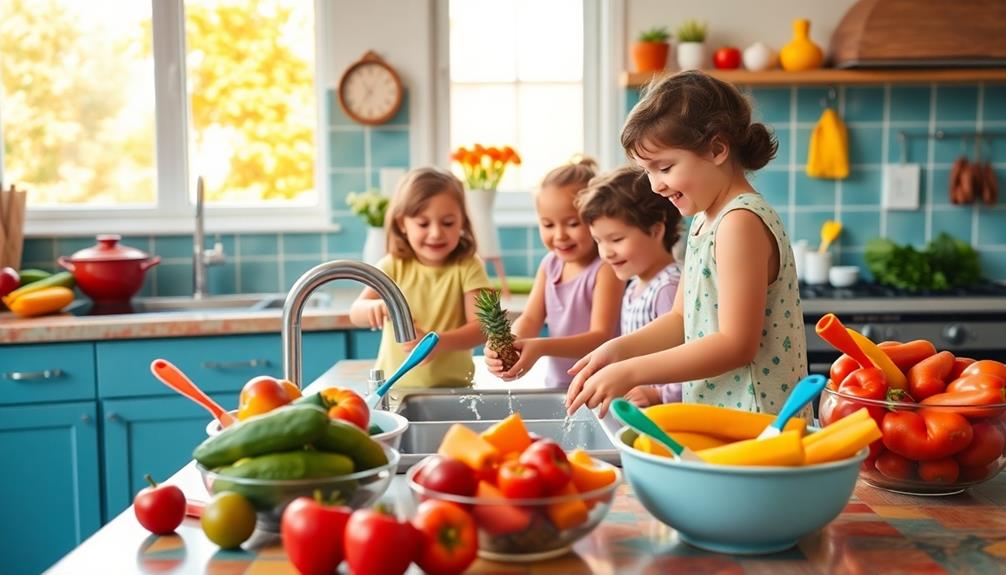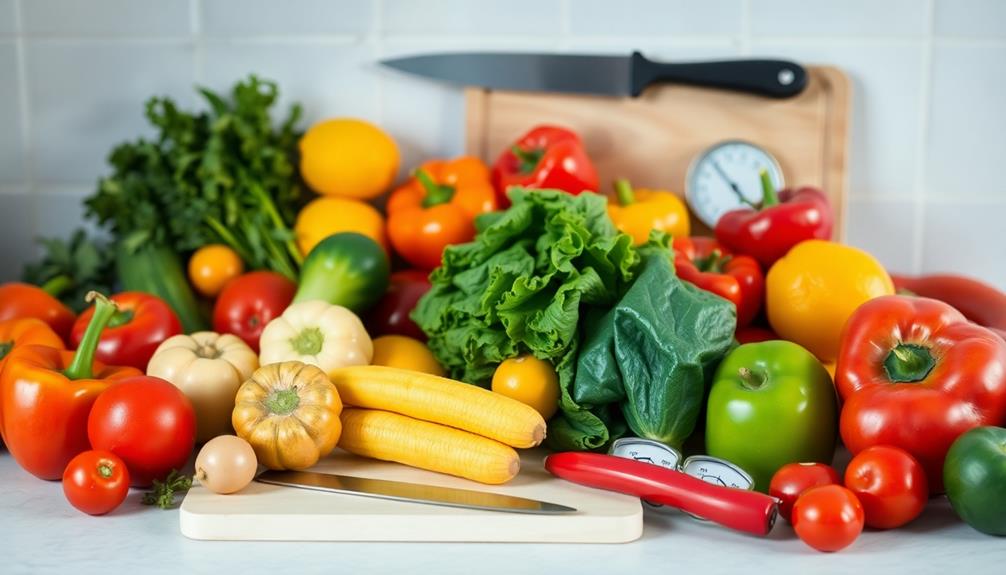Preventing cross-contamination in raw food kitchens is essential for food safety. Start by separating raw foods from ready-to-eat items. Always use different utensils and cutting boards for raw meats and fresh produce. Wash your hands thoroughly before and after handling raw foods to minimize bacteria spread. Regularly clean and sanitize surfaces right after food prep, as harmful bacteria can linger. Store raw meats on the bottom shelf of your refrigerator to avoid drips onto other foods. By following these practices, you create a safer cooking environment. Discover even more effective tips to enhance your kitchen safety.
Key Takeaways
- Separate raw meats, poultry, and seafood from ready-to-eat foods to prevent cross-contamination during storage and preparation.
- Use designated cutting boards and utensils for raw and cooked foods, washing them immediately after use.
- Maintain proper hand hygiene by washing hands thoroughly before and after handling raw foods with soap and water.
- Regularly clean and sanitize kitchen surfaces with hot, soapy water and a bleach solution after preparing raw foods.
- Organize shopping practices by using separate bags for raw meats and promptly refrigerating perishable items to avoid cross-contamination.
Understanding Cross-Contamination
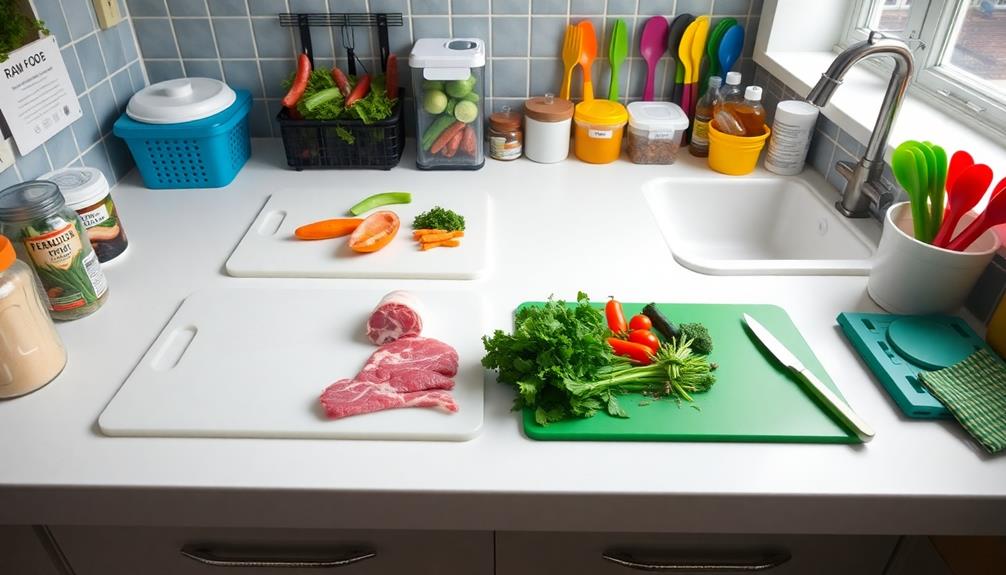
Understanding cross-contamination is essential for anyone working in a raw food kitchen. This process occurs when harmful bacteria transfer from one food item to another, often through raw meats, seafood, and unwashed produce.
It's imperative to recognize that high-risk groups like pregnant women, the elderly, children, and those with weakened immune systems are particularly vulnerable to foodborne illnesses resulting from cross-contamination.
To effectively prevent these risks, you need to be aware of the common sources of cross-contamination. Inadequate handwashing, sharing utensils, and improper food storage practices can all contribute to the spread of pathogens such as E. coli and salmonella.
Understanding the different types of cross-contamination—food-to-food, people-to-food, and object-to-food—is essential for implementing effective safety measures.
Safe Food Handling Practices
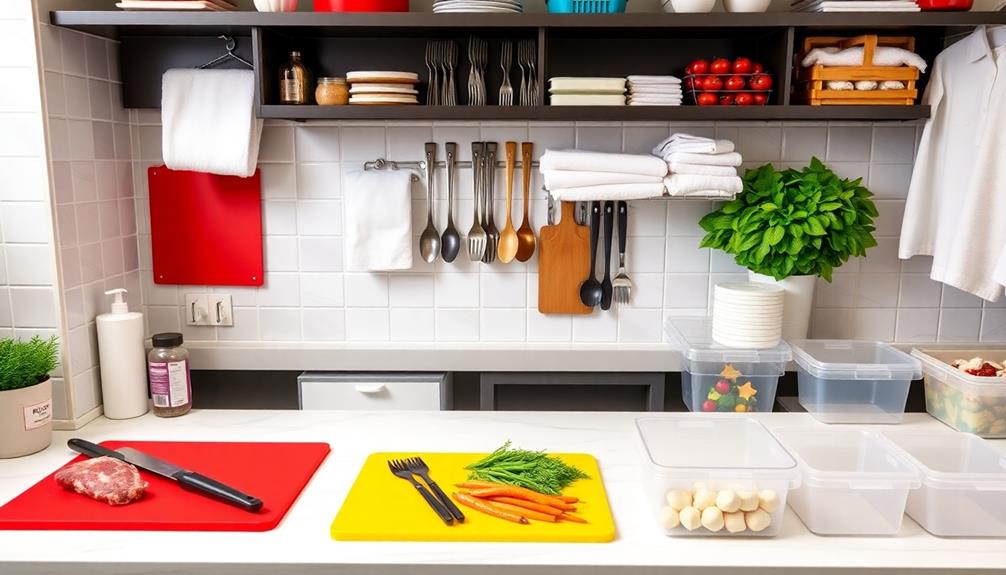
To keep your kitchen safe, you need to prioritize separation in your food handling.
Make certain you use the right utensils for raw and cooked foods and stick to a regular cleaning routine.
These practices will help you minimize the risk of cross-contamination and guarantee your meals are safe to enjoy.
Importance of Separation
Effective separation of raw foods from ready-to-eat items is essential in preventing cross-contamination in your kitchen. Always store raw meats, poultry, and seafood separately in the refrigerator—ideally on the bottom shelf. This setup prevents juices from dripping onto other items, which can lead to foodborne illnesses.
Utilizing separate cutting boards is also vital; one for raw meats and another for fresh produce. Studies show that 43% of surfaces contaminated with raw meat bacteria pose significant health risks.
When handling raw foods, wash your hands thoroughly before and after to reduce the spread of harmful bacteria. Research indicates that 80% of individuals don't wash their hands properly after handling raw mince, heightening the risk of contamination.
Additionally, always use separate utensils for raw foods and never reuse them for cooked items without washing. Alarmingly, 72% of people forget to wash knives after cutting raw chicken, risking cross-contamination.
Proper Utensil Usage
Using separate utensils for raw and cooked foods is vital for maintaining a safe kitchen environment. Proper utensil usage plays an essential role in preventing cross-contamination. Always designate specific cutting boards for raw meat and another for fresh produce. This minimizes the risk of harmful bacteria transfer, a necessity given that 72% of individuals fail to wash knives used for raw chicken before cutting vegetables.
After using utensils for raw meats, such as those involved in raw meat packaging, wash and sanitize them immediately. Studies show that 67% of surfaces tested were contaminated with raw meat bacteria post-preparation, underscoring the importance of adhering to food safety protocols.
Avoid using the same utensils for multiple food items without washing them first; 18% of tested knives showed contamination with Campylobacter.
Regularly inspect your utensils and replace any that are worn or damaged, as 43% of surfaces can harbor bacteria if cleaning practices are inadequate.
Regular Cleaning Protocols
Maintaining a clean kitchen is just as important as using the right utensils when it comes to preventing cross-contamination. Implement a regular cleaning schedule that prioritizes sanitizing surfaces and utensils immediately after they come into contact with raw foods.
Studies show that 43% of surfaces remain contaminated post-preparation, making this step essential. Use a food-safe disinfectant or a solution of 1 tablespoon of unscented liquid chlorine bleach per gallon of water to effectively sanitize surfaces after handling raw meat, which often harbors harmful bacteria like E. coli and salmonella.
Don't forget to replace sponges and dishcloths frequently, as 27.5% of tested dishcloths contained E. coli. Clean and sanitize cutting boards after each use, especially those used for raw meat, as 72% of individuals neglect this step, risking contamination of other foods.
Also, make certain everyone on your team is trained to wash their hands with warm water and soap for at least 20 seconds before and after handling food. Inadequate handwashing is a common source of cross-contamination, so make it a priority to keep your kitchen sanitized and free from harmful bacteria.
Hand Hygiene Importance
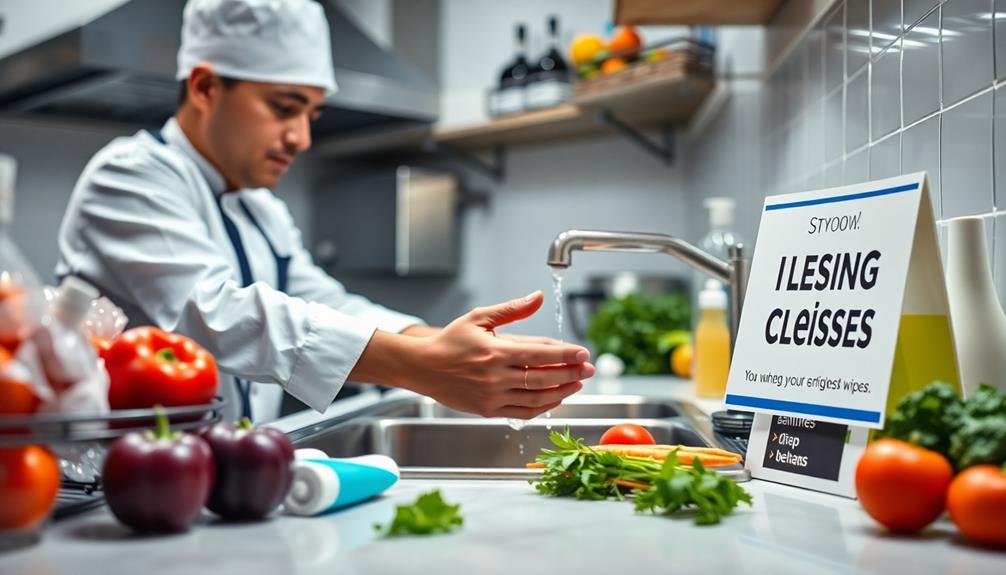
Hand hygiene plays a essential role in preventing cross-contamination in raw food kitchens. It's alarming to know that many people neglect proper handwashing, especially after handling raw meats. A staggering 80% of individuals don't wash their hands thoroughly after touching raw mince, and 84% fail to do so after handling raw chicken. This negligence can easily transfer harmful bacteria to ready-to-eat foods, increasing the risk of foodborne illnesses.
To guarantee effective hand hygiene, follow these simple rules:
| Action | Before Handling Raw Foods | After Handling Raw Foods |
|---|---|---|
| Wash your hands thoroughly | Yes | Yes |
| Use soap and water | Yes | Yes |
| Dry hands properly | Yes | Yes |
Moreover, studies reveal that 26% of individuals still have raw meat bacteria on their hands post-preparation. Remember, awareness of hand contact with surfaces is essential, as improper hygiene can greatly contribute to the spread of foodborne pathogens. So, make it a habit to wash your hands—your health and the safety of others depend on it!
Cleaning Kitchen Surfaces
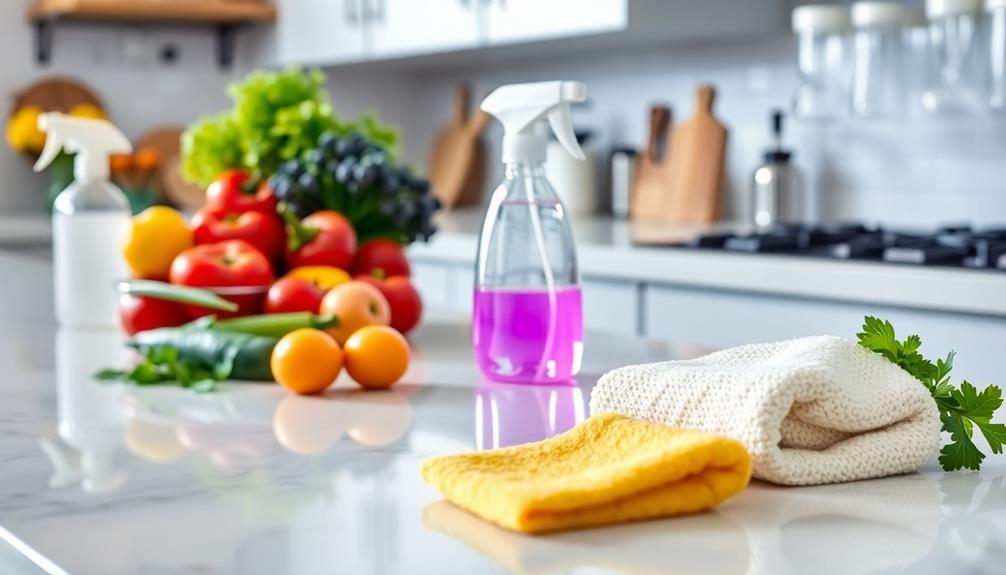
When it comes to cleaning kitchen surfaces, you need to focus on effective sanitization techniques and how often you clean.
Using safe cleaning products can greatly reduce the risk of harmful bacteria lingering on counters and cutting boards.
Establishing a routine guarantees that your kitchen remains a safe environment for food preparation.
Surface Sanitization Techniques
To effectively combat harmful bacteria in your kitchen, it's important to implement thorough surface sanitization techniques. Whenever you handle raw foods, especially raw meat, make it a priority to clean and sanitize surfaces immediately after use. Harmful bacteria can linger for up to 24 hours if not properly addressed, posing a considerable risk of cross-contamination.
Start by washing surfaces with hot, soapy water to remove food particles and bacteria. This step is essential as it provides a clean base for your sanitizing solution. You can create an effective sanitizing solution by mixing 1 tablespoon of unscented liquid chlorine bleach per gallon of water. Use this solution to thoroughly sanitize your countertops and cutting boards, ensuring a reduction in bacteria like E. coli and Salmonella.
Regular cleaning schedules are imperative. Studies reveal that 96% of kitchen surfaces aren't thoroughly washed after food preparation, emphasizing the need for consistent sanitization practices.
Frequency of Cleaning
Cleaning and sanitizing kitchen surfaces regularly is essential in preventing cross-contamination. You mightn't realize how easily harmful bacteria can transfer in your kitchen, especially after handling raw foods.
Here are some key points to evaluate:
- 43% of surfaces were contaminated with raw meat bacteria post-preparation.
- Campylobacter can survive on surfaces for up to 1 hour.
- E. coli can persist for up to 24 hours, increasing the risk of foodborne illness.
- 67% of individuals fail to wash chopping boards after cutting raw chicken.
- 96% of kitchen surfaces weren't thoroughly washed after food prep.
To guarantee food safety, clean and sanitize surfaces immediately after contact with raw meat.
Establish a regular cleaning schedule to prevent bacterial buildup. Always sanitize chopping boards after use, and don't forget to clean countertops, utensils, and any other surfaces that come into contact with raw foods.
Utilize a food-safe disinfectant or a bleach solution after cleaning to eliminate harmful bacteria.
Safe Cleaning Products
Using safe cleaning products is essential for maintaining a hygienic kitchen free from harmful bacteria. Start by cleaning kitchen surfaces with hot, soapy water before you begin food preparation. This step helps remove any residual contaminants and reduces the risk of cross-contamination.
Additionally, consider incorporating natural cleaning alternatives like essential oils for aromatherapy, which can provide antibacterial properties while leaving your kitchen smelling fresh. After handling raw foods, especially raw meat, sanitize the surfaces using a food-safe disinfectant or a solution of 1 tablespoon of unscented liquid chlorine bleach per gallon of water. This effective method kills harmful bacteria and keeps your kitchen safe.
Don't forget to replace sponges and dishcloths regularly. Studies show that 27.5% of dishcloths contain E. coli, which can easily transfer bacteria to your surfaces and food. Implementing a routine cleaning schedule can help guarantee that all kitchen surfaces and utensils are sanitized frequently, particularly after contact with raw foods.
Always choose safe cleaning products that are appropriate for food contact surfaces and free from harsh chemicals. This way, you can prevent their juices or residues from contaminating your meals, maintaining a safe cooking environment for everyone.
Proper Cooking Temperatures
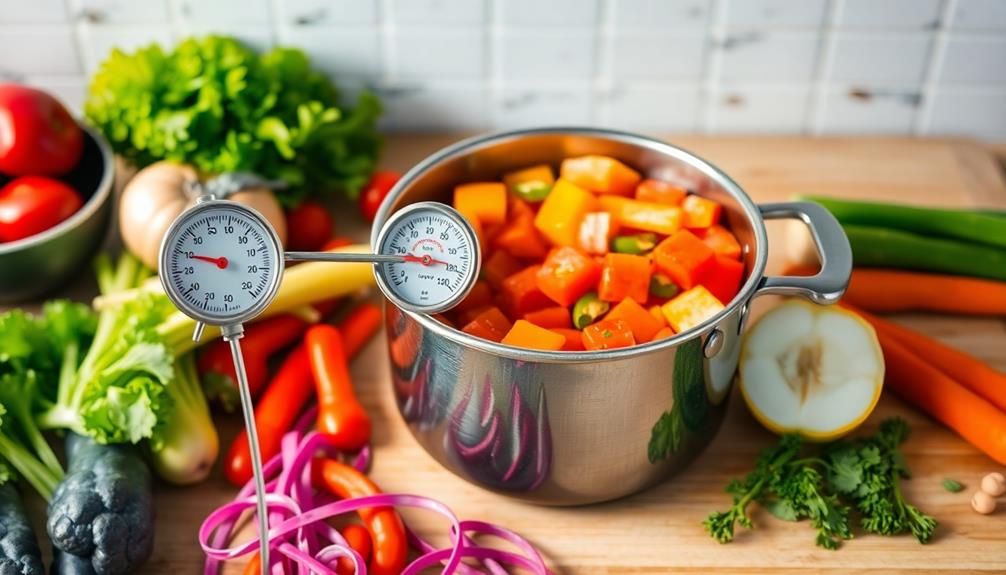
How can you guarantee the safety of the food you prepare in a raw food kitchen? One of the key factors is ensuring that all cooked food reaches the proper internal temperature. This step is essential to eliminate harmful bacteria and prevent foodborne illnesses.
Here are some important cooking temperatures to keep in mind:
- Poultry: Cook to an internal temperature of 165°F (74°C)
- Ground meats: Minimum internal temperature of 160°F (71°C)
- Seafood: Cook to at least 145°F (63°C)
- Leftovers: Reheat to an internal temperature of 165°F (74°C)
- Use a food thermometer: This tool is crucial for checking the internal temperatures accurately.
Storage Recommendations
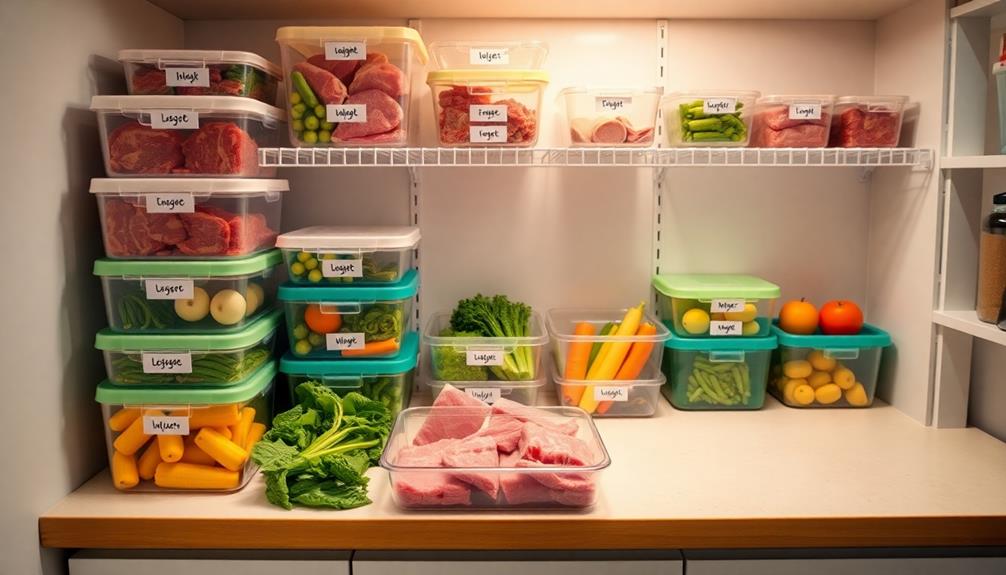
To guarantee food safety in a raw food kitchen, proper storage practices are essential. Start by storing raw meats, poultry, and seafood on the bottom shelf of your refrigerator in sealed containers or bags. This helps prevent juices from dripping onto other foods, reducing the risk of cross-contamination.
It's also vital to maintain your refrigerator temperature at or below 40°F (4°C) to inhibit bacterial growth.
Always keep raw meat separate from ready-to-eat foods like fruits and vegetables. This separation minimizes the chance of contamination. To keep track of freshness, label and date your raw food items. Most fresh meats should be consumed or discarded within a few days.
If you won't use any raw meat within that timeframe, freeze it to prevent spoilage and further reduce the risk of cross-contamination.
By following these storage recommendations, you'll create a safer environment in your raw food kitchen, ensuring that your meals are both delicious and safe to eat.
Safe Shopping Techniques
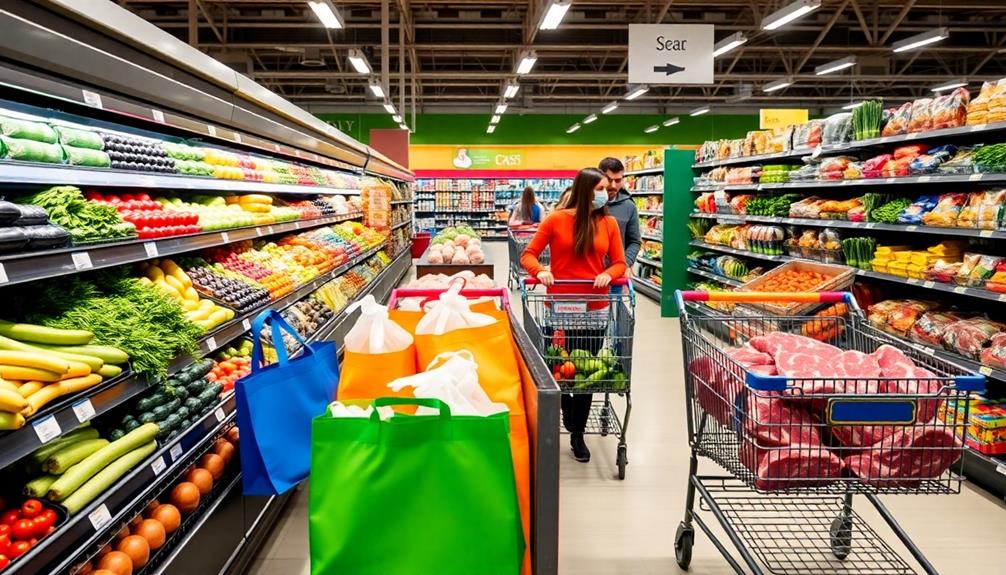
When you're shopping for raw food, organizing your cart is essential to prevent cross-contamination.
Keep raw meat, poultry, and seafood separate from other items, and use plastic bags to contain them.
At checkout, confirm these items stay apart from ready-to-eat foods to minimize the risk of bacteria spreading.
Cart Organization Strategies
During your next grocery trip, organizing your cart effectively can greatly reduce the risk of cross-contamination.
Implementing smart cart organization strategies is key to food safety, especially when handling raw meats. Here's how to keep your groceries safe:
- Use separate plastic bags for raw meat, poultry, and seafood.
- Place raw meats on the bottom shelf of your cart.
- Keep raw meat packages away from fresh produce and ready-to-eat items.
- Use distinct bags for raw and cooked foods at checkout.
- Promptly refrigerate or freeze perishable items after shopping.
Checkout Safety Practices
Implementing safe checkout practices is vital for preventing cross-contamination and ensuring food safety. When you're at the grocery store, always bag raw meats, poultry, and seafood separately from other foods. This helps prevent juices from contaminating ready-to-eat items, which can lead to foodborne illnesses. Use plastic bags to contain any potential leaks during checkout, keeping these items separate in your grocery bags.
Maintain a clear separation of raw and cooked foods throughout your shopping experience. This includes your shopping cart and the checkout counter. Be mindful that bacteria from raw meat packaging can transfer to other items, with studies showing that 13% of chicken packaging may be contaminated with Campylobacter.
Even after shopping, it's essential to practice safe storage. Store raw meats on the bottom shelf of your refrigerator to avoid drips onto other foods.
Training for Food Safety
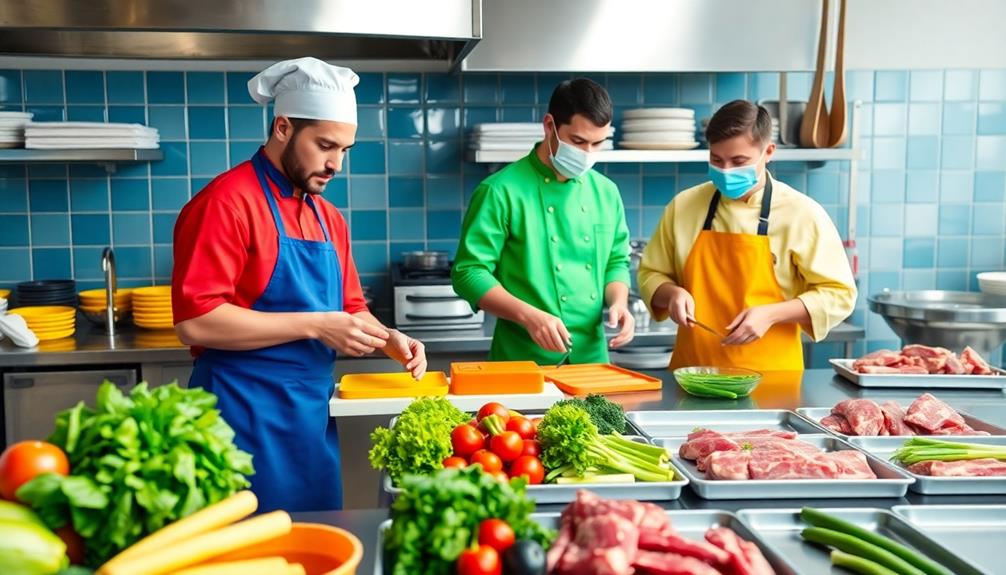
In a raw food kitchen, thorough training for kitchen staff is essential to ensuring safe food handling practices. By investing in extensive training, you greatly reduce the risk of cross-contamination and foodborne illnesses.
Here are some key components of effective training for food safety:
- Emphasize the importance of washing hands thoroughly, especially after handling raw meat.
- Use visual aids like posters to remind staff of safe food handling procedures.
- Conduct regular assessments and refresher courses to reinforce knowledge.
- Foster open communication, encouraging staff to report unsafe practices.
- Create a culture of safety focused on continuous improvement.
It's vital to understand that studies indicate 80% of individuals fail to wash their hands thoroughly after handling raw meat, underscoring the need for effective training on hand hygiene.
When you implement these strategies, you not only enhance compliance with safe food handling practices but also promote a proactive approach to prevent cross-contamination.
Monitoring Food Preparation

Effective monitoring of food preparation is imperative for maintaining safety in a raw food kitchen. You need to regularly inspect food prep areas to guarantee strict adherence to safety protocols, including proper handwashing and sanitation practices.
Implementing a system for tracking the use of separate utensils and cutting boards is essential to prevent cross-contamination between raw foods and cooked items.
Routine inspections of kitchen surfaces are critical, as studies show a staggering 96% of surfaces aren't thoroughly cleaned after food prep, which can lead to potential contamination.
Educate your kitchen staff about harmful bacteria, such as E. coli, which can survive for up to 24 hours on surfaces. This knowledge emphasizes the importance of immediate cleaning.
Utilizing checklists can help verify that all food items, especially high-risk products like raw meat and seafood, are stored and handled correctly.
By prioritizing monitoring food preparation, you minimize cross-contamination risks and create a safer environment for everyone involved.
Ongoing Awareness and Compliance

Maintaining a kitchen's safety is a shared responsibility that hinges on ongoing awareness and compliance among all staff members. You play a vital role in preventing cross-contamination and ensuring food safety by staying informed and vigilant.
Here are some key practices to keep in mind:
- Attend regular training sessions on safe food handling.
- Follow proper handwashing techniques consistently.
- Use separate utensils for raw and cooked foods.
- Participate in routine inspections of food preparation areas.
- Foster a culture of safety and accountability within the team.
By committing to these practices, you'll help reduce the risk of harmful bacteria spreading in the kitchen. Compliance with local health department guidelines is essential, as it directly impacts food safety.
Regular training enhances ongoing awareness, reminding everyone of the importance of safe food handling. Additionally, routine inspections can help identify potential risks, ensuring that surfaces and equipment are cleaned and sanitized frequently.
Encouraging open communication about food safety reinforces the importance of compliance. When everyone in the kitchen embraces these practices, you create a safer environment for both staff and customers, minimizing the chances of cross-contamination effectively.
Frequently Asked Questions
How to Prevent Cross Contamination in Kitchen?
To prevent cross-contamination in your kitchen, wash your hands often, use separate cutting boards, store raw foods properly, and clean surfaces immediately after use. Staying organized and aware helps keep your food safe.
How Did You Store Raw Food to Prevent Cross Contamination?
You've got your refrigerator organized perfectly. You store raw meat on the bottom shelf in sealed containers, keep fruits and veggies separate, and regularly check for expired items to maintain freshness and safety.
What Are the 5 Guidelines for Preventing Cross Contamination of Food?
To prevent cross-contamination, you should wash your hands frequently, use separate utensils for different food types, store raw items properly, clean surfaces after use, and train staff on safe handling practices regularly.
What Is Cross Contamination of Raw Foods?
Cross-contamination of raw foods happens when harmful bacteria transfer from one food to another. It can occur through improper handling, unwashed surfaces, or contaminated utensils, putting your health at risk if not managed properly.
Conclusion
By embracing safe food handling practices and maintaining vigilance against cross-contamination, you're not just protecting your meals; you're safeguarding the health of everyone who shares your table. Remember, even the finest recipes can fall flat if you ignore the basics. Like a well-tuned orchestra, every element in your kitchen must work in harmony. Stay aware, keep training, and let your kitchen be a sanctuary of safety, ensuring that every bite is as wholesome as it is delicious.
